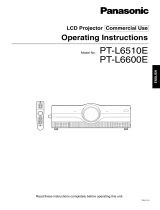ENGLISH-5
Preparation
Contents
Preparation
IMPORTANT SAFETY NOTICE ...2
Precautions with regard to
safety .........................................6
Accessories ...............................10
Before use ..................................11
Location and function of each
part...........................................13
Getting started
Setting-up...................................18
Projection methods, Projector
position, Projection distances
Connections...............................21
Connecting to computer,
Connecting to video equipment
Preparation for the remote
control unit..............................23
Basic operation
Turning on the power................24
Turning off the power................26
Useful functions
Correcting keystone distortion
and automatic positioning.....28
Turning off the picture and sound
momentarily ............................29
Pausing a picture.......................29
Enlarging the picture.................30
Adjusting the volume ................30
Displaying two screens.............31
Adjustments and settings
On-screen menus ......................32
Menu screens, Menu operation
guide, Returning a setting to the
factory default
Correcting keystone
distortion .................................36
Adjusting the picture.................37
PICTURE MODE, CONTRAST,
BRIGHT, COLOR, TINT,
SHARPNESS, COLOR TEMP.,
White balance R/G/B,
DAYLIGHTVIEW, AI,
TV-SYSTEM, STILL MODE,
SIGNAL MODE, Projecting sRGB-
compatible pictures
Adjusting the position...............41
POSITION, DOT CLOCK, CLOCK
PHASE, ASPECT, RESIZING,
FRAME LOCK
Changing the display
language..................................44
Option settings ..........................45
OSD, AUTO SEARCH, AUTO
SIGNAL, AUTO KEYSTN, RGB2
SELECT, RGB/YPBPR, VGA60/480p,
SXGA MODE, Noise Reduction (NR),
BLACKBOARD, BACK COLOR,
FRONT/REAR, DESK/CEILING, FAN
CONTROL, LAMP POWER, LAMP
RUNTIME, FUNC 1, CONTROL KEY,
AUTO POW.OFF, POWER
MEMORY
Setting up the security
function ...................................49
INPUT PASSWD, AMEND
PASSWD, TEXT DISPLAY, TEXT
CHANGE
Network setup............................51
Care and maintenance
When the TEMP indicator and the
LAMP indicator are
illuminated...............................52
Cleaning and replacing
the air filter ..............................54
Replacing the lamp unit ............55
Before calling for service..........58
Cleaning and maintenance .......59
Others
Specifications ............................60
Appendix ....................................62
List of compatible signals, Projection
dimensions calculation methods,
Using the SERIAL connector
Dimensions ................................66
Trademark
acknowledgements ................66




















